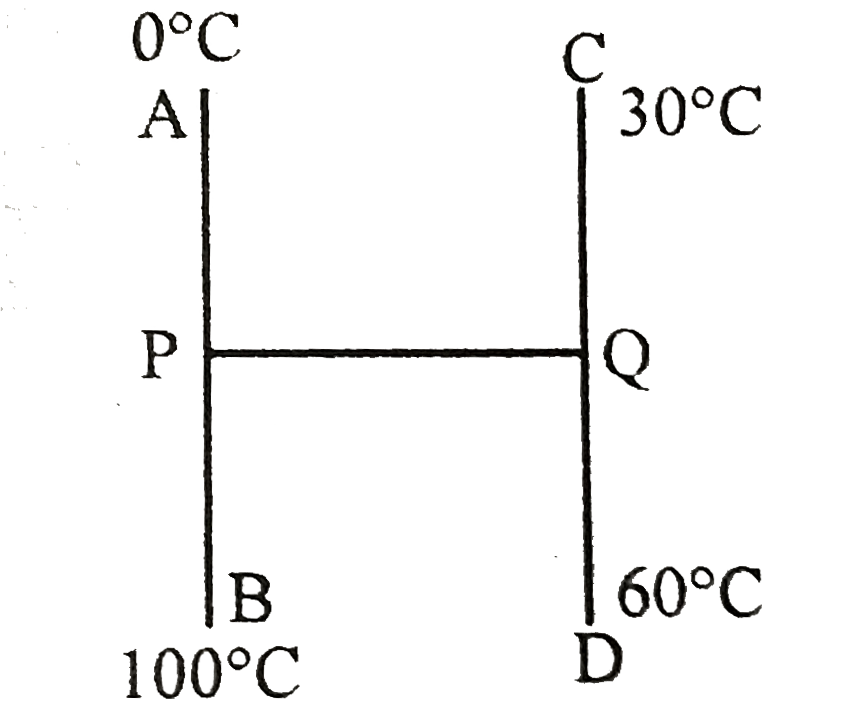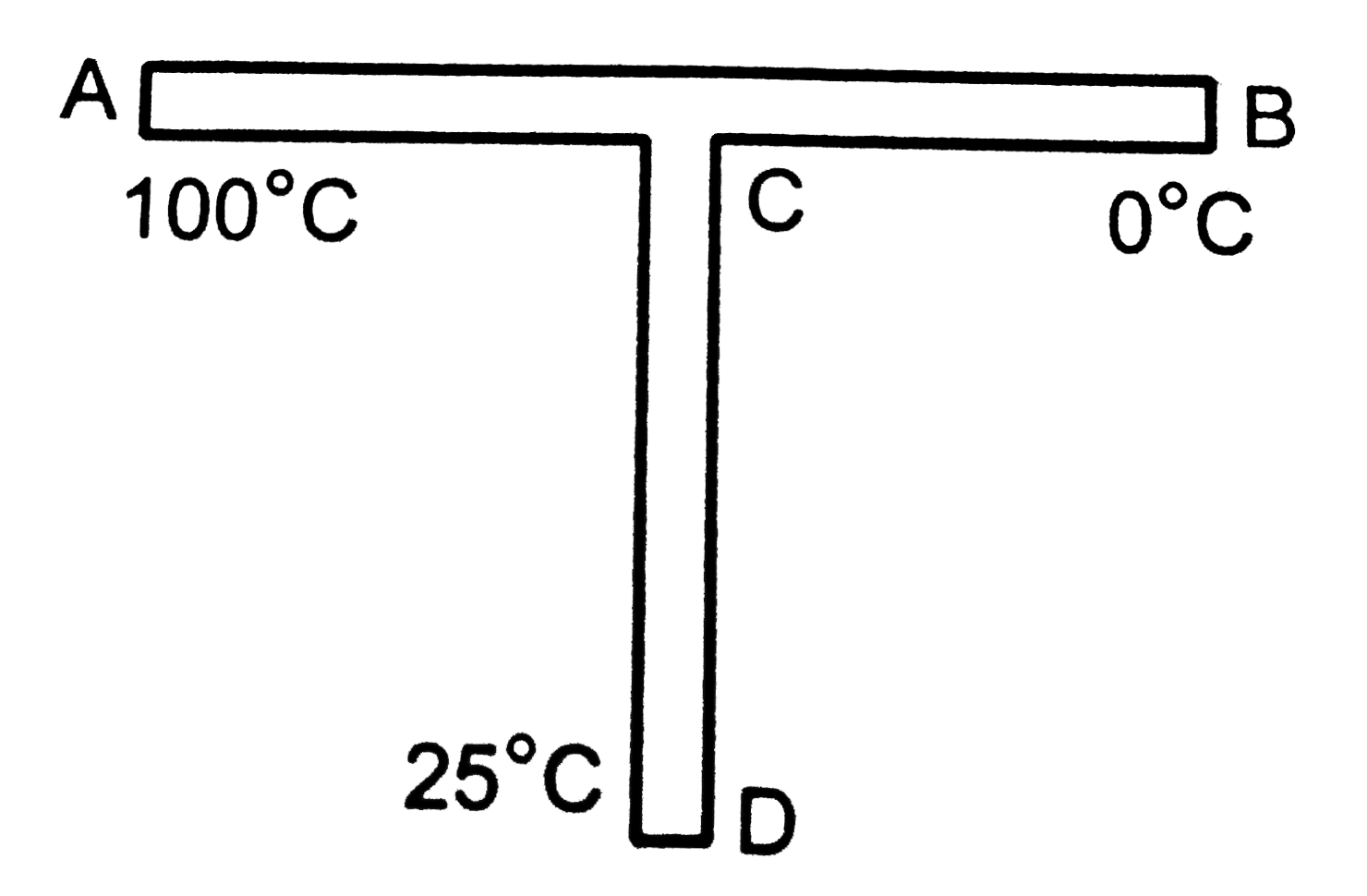Three identical rods AB, CD and PQ are joined as shown. P and Q are mid points of AB and CD respectively. Ends A, B, C and D are maintained at 0∘C, 100∘C, 30∘C and 60∘C respectively. The direction of heat flow in PQ is
 Solution in Gujrati
Solution in Gujrati
(a)From P to Q
(b)From Q to P
(c)Heat does not flow in PQ
(d)Data not sufficient
The correct Answer is:A
Tp=50∘C,TQ=45∘C
∴ Heat will flow from P to Q.
Topper's Solved these Questions
- GEOMETRICAL OPTICSBOOK - ALLEN CHAPTER - GEOMETRICAL OPTICSEXERCISE - EXERCISE -03
11 Videos
- GEOMETRICAL OPTICSBOOK - ALLEN CHAPTER - GEOMETRICAL OPTICSEXERCISE - ASSERTION-REASON
40 Videos
- GEOMETRICAL OPTICSBOOK - ALLEN CHAPTER - GEOMETRICAL OPTICSEXERCISE - EXERCISE -01
65 Videos
- CURRENT ELECTRICITYBOOK - ALLEN CHAPTER - CURRENT ELECTRICITYEXERCISE - EX.II
66 Videos
- GRAVITATIONBOOK - ALLEN CHAPTER - GRAVITATIONEXERCISE - EXERCISE 4
9 Videos
Similar Questions
Three liquids A,B and C having same specific heat and mass m , 2m and 3 m have temperature 20∘C,40∘C and 60∘C respectively. Temperature of the mixture when:
Column-IColumn-II(A)A and B are mixed(p)33∘C(B)A and C are mixed(q)52∘C(C)B and C are mixed(r)50∘C(D)A,B and C all three are mixed(s)46∘C(t)None
View SolutionStatement-1: A real gas behaves as an ideal gas at high temperature and low pressure .
Statement-2: Liquid state of an ideal gas is impossible.
View SolutionOn an X temperature scale, water freezes at −125.0∘X and boils at 375.0∘X. On a Y temperature scale, water freezes at −70.0∘Y and boils at −30.0∘Y. The value of temperature on X-scale equal to the temperature of 50.0∘Y on Y-scale is
View SolutionIn the Bohr's model of hy drogen atom, the electron moves around the nucleus in a circular orbit of radius 5×10−11m. Its time period is 1.5×10−16s. The current associated with the electron motion is:-
View SolutionAssertion : The difference in the value of acceleration due to gravity at pole and equator is proportional to square of angular velocity of earth.
Reason : the value of acceleration due to gravity is minimum at the equator and maximum at the pole.
View SolutionA rod CD of thermal resistance 5.0KW−1isjo∈edatthem≤ofannticalrodABasshown∈figure.TheendsA,BandDarema∫a∈edat100^(@)C,0(@)C and 25(@)C respectively. Find the heat current in CD.

View SolutionThree identical rods AB , CD and PQ are joined as shown. P and Q are mid points of AB and CD respectively. Ends A , B , C and D are maintained at 0^(@)C , 100^(@)C , 30^(@)C and 60^(@)C respectively. The direction of heat flow in PQ is
View SolutionThree identical rods AB, CD and PQ are joined as shown. P and Q are mid point of AB and CD respectively. Ends A, B, C and D are maintained at 0^(@)C, 100^(@)C,30^(@)C and 60^(@)C respectively. The direction of heat flow in PQ is
View Solutionकिसी धातु की छड़ के दो सिरों के तापों को क्रमशः 100∘C तथा 110∘C पर रखा जाता है जिससे छड़ में ऊष्मा का प्रवाह 4.0 जूल/से पाया जाता है।यदि इन सिरों के तापों को क्रमशः 200∘C तथा 210∘C पर रखा जाये तो ऊष्मा प्रवाह होगा:
View SolutionThe determinant ∣∣ ∣ ∣∣2a+b+c+dab+cda+b+c+d2(a+b)(c+d)ab(c+d)+cd(a+b)ab+cdab(c+d)+cd(a+b)2abcd∣∣ ∣ ∣∣=0 for
View SolutionThe determinant ∣∣ ∣ ∣∣2a+b+c+dab+cda+b+c+d2(a+b)(c+d)ab(c+d)+cd(a+b)ab+cdab(c+d)+cd(a+b)2abcd∣∣ ∣ ∣∣=0 for
View SolutionA rod CD of thermal resistance 5.0KW−1 is joined at the middle of an identical rod AB as shown in figure. The ends A, B and D are maintained at 100∘C , 0∘C and 25∘C respectively. Find the heat current in CD.

View SolutionIf a, b, c and d are complex numbers then the determinant Delta=|(2,a+b+c+d,ab+cd),(a+b+c+d,2(a+b)(c+d),ab(c+d)+cd(a+b)),(ab+cd,ab(c+d)+cd(a+d),2abcd)|
View SolutionA rod CD of thermal resistance 5.0KW−1 is joined at the middle of an identical rod AB as shown in figure. The ends A,B and D are maintained at 100∘C , 0∘C and 25∘C respectively. Find the heat current in CD.

View SolutionThree identical rods AB, CD and PQ are joined as shown. P and Q are mid points of AB and CD respectively. Ends A, B, C and D are maintained at 0∘C, 100∘C, 30∘C and 60∘C respectively. The direction of heat flow in PQ is

View Solution
